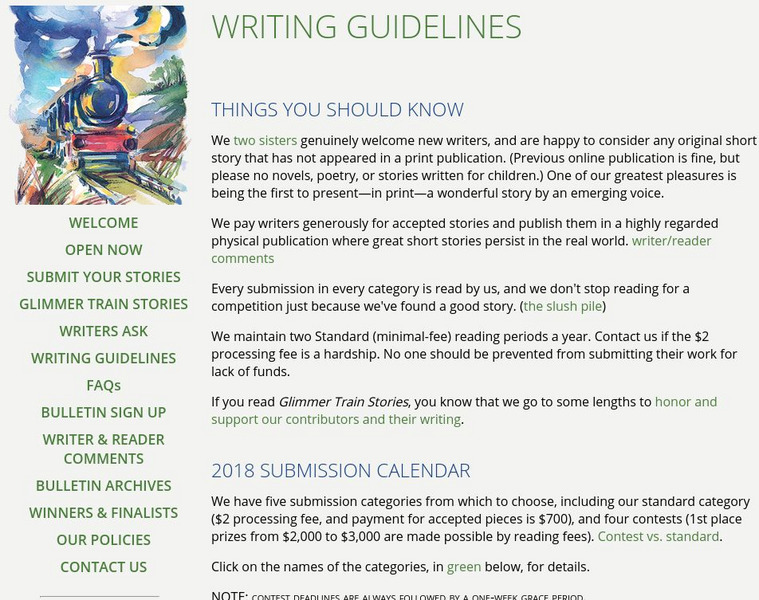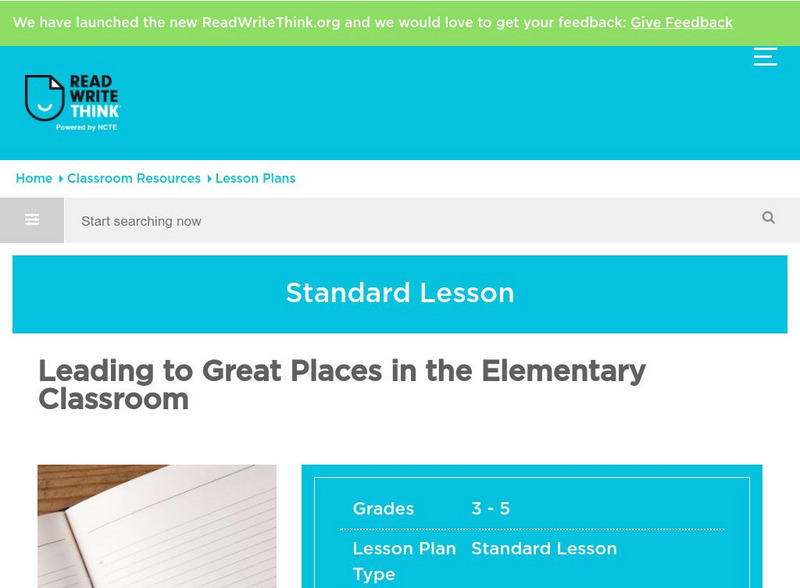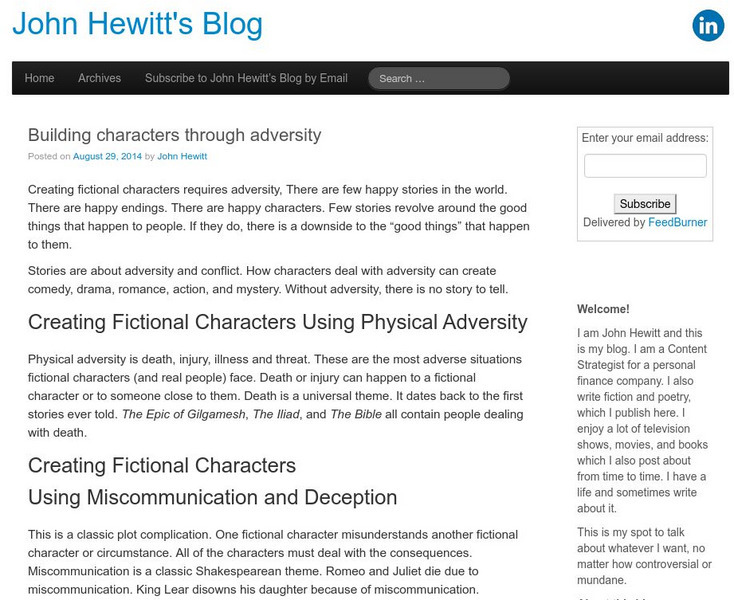Curated OER
Compare and Contrast Nonfiction Texts
Explore nonfiction writing by comparing and contrasting two different texts. After reading two nonfiction books, articles, or magazines, students utilize a graphic organizer to record their similarities and differences. They answer study...
Curated OER
The Importance Setting and Mood in Fiction
Seventh graders examine the setting in pieces of fiction. In this story analysis lesson, 7th graders investigate the setting in fictional stories and the importance it has. Students discover new vocabulary terms applying to storytelling.
Curated OER
Reading Fiction: Analyzing Sentences
Students investigate sentence construction in fiction. In this sentence construction lesson, students examine examples of fiction work and discover why sentences are a certain length. Students create their own passages playing with...
Curated OER
Bug's Eye View
Pupils explore biology by writing fictitious stories in class. In this insect life lesson, students identify many different types of insects in the animal kingdom and the classifications they fall into. Pupils collect insects on a field...
Curated OER
Writing a Fantasy Story - Time Travel
Students write a fantasy story about time traveling back to the time of the Oregon Trail. In this Oregon trail lesson students gather information from their Social Studies textbook about life during the time of the Oregon Trail.
Curated OER
Elements of Fiction
Learners investigate themes and settings in their favorite fiction stories. In this creative writing lesson plan, students discuss the reasons a fictional story works well and discuss ways to create their own. Learners create their own...
Curated OER
Writing Fiction
In this story-writing worksheet, students complete 20 blanks in two different graphic organizers. Each graphic organizer guides students through creating interesting story characters.
Curated OER
Fact or Fantasy Writing
First graders see that some written text is for pleasure and enjoyment while some is for relaying information. They get to experience both types during the lesson. They brainstorm ideas for a story about a new kid in school to write about.
TED Talks
Ted: Ted Ed: How to Write Descriptively
The point of fiction is to cast a spell, a momentary illusion that you are living in the world of the story. But how do writers suck readers into stories in this way? Nalo Hopkinson shares some tips for how to use language to make your...
Other
Barbara Greenwood's Guide to Writing for Children [Pdf]
Barbara Greenwood, a Canadian author of numerous historical fiction books for children, has written this thirty-page writing guide where she explains the process she goes through in constructing a story. She covers such key topics as...
Other
Glimmer Train Press: Writing Guidelines
Glimmer Train accepts entries from both published and upcoming writers, although there is a separate category for new writers. Deadlines and additional information are given at this site. (It would be wise to click on the Short-Story...
ReadWriteThink
Read Write Think: Leading to Great Places in the Classroom
We all know that the most effective way to teach reading is to start with reading. This lesson uses that approach with writing story leads.
Other
Building Characters With Adversity
Extensive and very interesting article advising the reader on how to develop characters through adversity.
British Library
British Library: 20th Century Teaching Resources: Angela Carter's Wise Children
In these activities, young scholars will focus on a wealth of drafting material and writer's notebooks to reveal how Angela Carter created her final comic novel, "Wise Children". They will closely examine fascinating source documents and...
Other
Nottingham Trent University: Kids on the Net
Visit this site for children's writing made by kids. Kids on the Net aims to help children develop a useful and informed approach to the Internet and how to use it for writing.
BBC
Bbc Bitesize: Higher English
This site provides information about characters, plot, and setting of several different pieces of literature. It offers links to activities and tests on topic such as analysis and evaluation, creation and production, drama, novels, and...
ReadWriteThink
Read Write Think: Choose Your Own Adventure: A Hypertext Writing Experience
This series of lessons involves student collaboration, writing and analytical skills, technology and imagination. While the lesson suggests use of FrontPage, it would also be possible to use a number of other authoring tools.
Other
Write4 kids.com
This site provides a great deal of information on writing children's stories. Contains "Advice, instruction, insider tips, insight and inspiration."
Caro Clarke
Writing Advice: Don't Get It Right the First Time
How much of your novel have you written? Do you keep starting it and never finishing it? Learn the answers to these questions in this novel-writing advice piece.
Caro Clarke
Loving Your Characters Too Much
This article is the fifth in a series that is designed to help new authors with their new novels. This lesson focuses on your main character and what happens when that character lacks character flaws.
Caro Clarke
Caro Clarke: What Is Conflict?
This is the sixth in a series of articles designed to help the new writer with their novel. This article focuses on conflict and how it effects the characters and the plot of the story. W.11-12.3a Narratives
Caro Clarke
Not Stopping the Reader: How to Avoid Stumbling Blocks
This is the eighth article in a series that focuses on helping the new novel author. This article looks at how the author can avoid creating stumbling blocks that disrupt the flow of the novel.
Caro Clarke
A, B, and C Characters
This is the ninth article in a series that focuses on helping the new novel author. This article focuses on what the author calls "A, B, and C Characters," used to describe the different levels of characters.
Caro Clarke
Explaining Too Much: Why More Is Less
This is the eleventh article in a series that is designed to help the new novel author. This article focuses on how to eliminate needless information in your novel. The key is to not explain too much about the action.



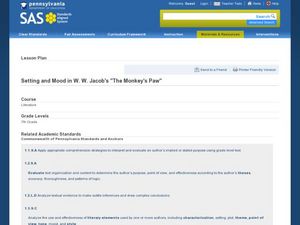

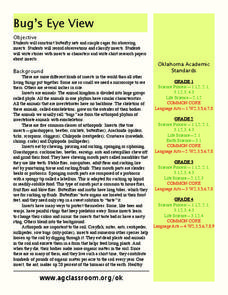





![Barbara Greenwood's Guide to Writing for Children [Pdf] eBook Barbara Greenwood's Guide to Writing for Children [Pdf] eBook](https://d15y2dacu3jp90.cloudfront.net/images/attachment_defaults/resource/large/FPO-knovation.png)
